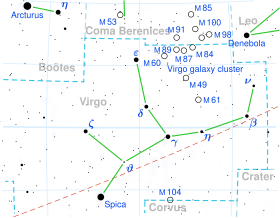Iota Virginis (ι Virginis, abbreviated Iota Vir, ι Vir) is a binary star in the constellation of Virgo. Its apparent magnitude is 4.08.[2] Based on its parallax, it is assumed to be relatively nearby, at 71.8 light-years (22.0 parsecs).[1]
Its two components are designated Iota Virginis A (officially named Syrma /ˈsɜːrmə/,[7] the traditional name for the system)[8] and B.
- ^ a b c d e f Vallenari, A.; et al. (Gaia collaboration) (2023). "Gaia Data Release 3. Summary of the content and survey properties". Astronomy and Astrophysics. 674: A1. arXiv:2208.00211. Bibcode:2023A&A...674A...1G. doi:10.1051/0004-6361/202243940. S2CID 244398875. Gaia DR3 record for this source at VizieR.
- ^ a b Gray, R. O.; Napier, M. G.; Winkler, L. I. (2001). "The Physical Basis of Luminosity Classification in the Late A-, F-, and Early G-Type Stars. I. Precise Spectral Types for 372 Stars". The Astronomical Journal. 121 (4): 2148. Bibcode:2001AJ....121.2148G. doi:10.1086/319956.
- ^ a b c d e Gontcharov, G.A.; Kiyaeva, O.V. (2010). "Photocentric orbits from a direct combination of ground-based astrometry with Hipparcos II. Preliminary orbits for six astrometric binaries". New Astronomy. 15 (3): 324–331. arXiv:1606.08182. Bibcode:2010NewA...15..324G. doi:10.1016/j.newast.2009.09.006. S2CID 119252073.
- ^ a b Mermilliod, J.-C. (1986). "Compilation of Eggen's UBV data, transformed to UBV (unpublished)". Catalogue of Eggen's UBV Data. Bibcode:1986EgUBV........0M.
- ^ a b Aguilera-Gómez, Claudia; Ramírez, Iván; Chanamé, Julio (2018-06-01). "Lithium abundance patterns of late-F stars: an in-depth analysis of the lithium desert". Astronomy and Astrophysics. 614: A55. arXiv:1803.05922. Bibcode:2018A&A...614A..55A. doi:10.1051/0004-6361/201732209. ISSN 0004-6361. Iota Virginis' database entry at VizieR.
- ^ a b c d Baines, Ellyn K.; Clark, James H., III; Schmitt, Henrique R.; Stone, Jordan M.; von Braun, Kaspar (2023-12-01). "33 New Stellar Angular Diameters from the NPOI, and Nearly 180 NPOI Diameters as an Ensemble". The Astronomical Journal. 166 (6): 268. Bibcode:2023AJ....166..268B. doi:10.3847/1538-3881/ad08be. ISSN 0004-6256.
{{cite journal}}: CS1 maint: multiple names: authors list (link) - ^ "syrma". Oxford English Dictionary (Online ed.). Oxford University Press. (Subscription or participating institution membership required.)
- ^ "Naming Stars". IAU.org. Retrieved 16 December 2017.
